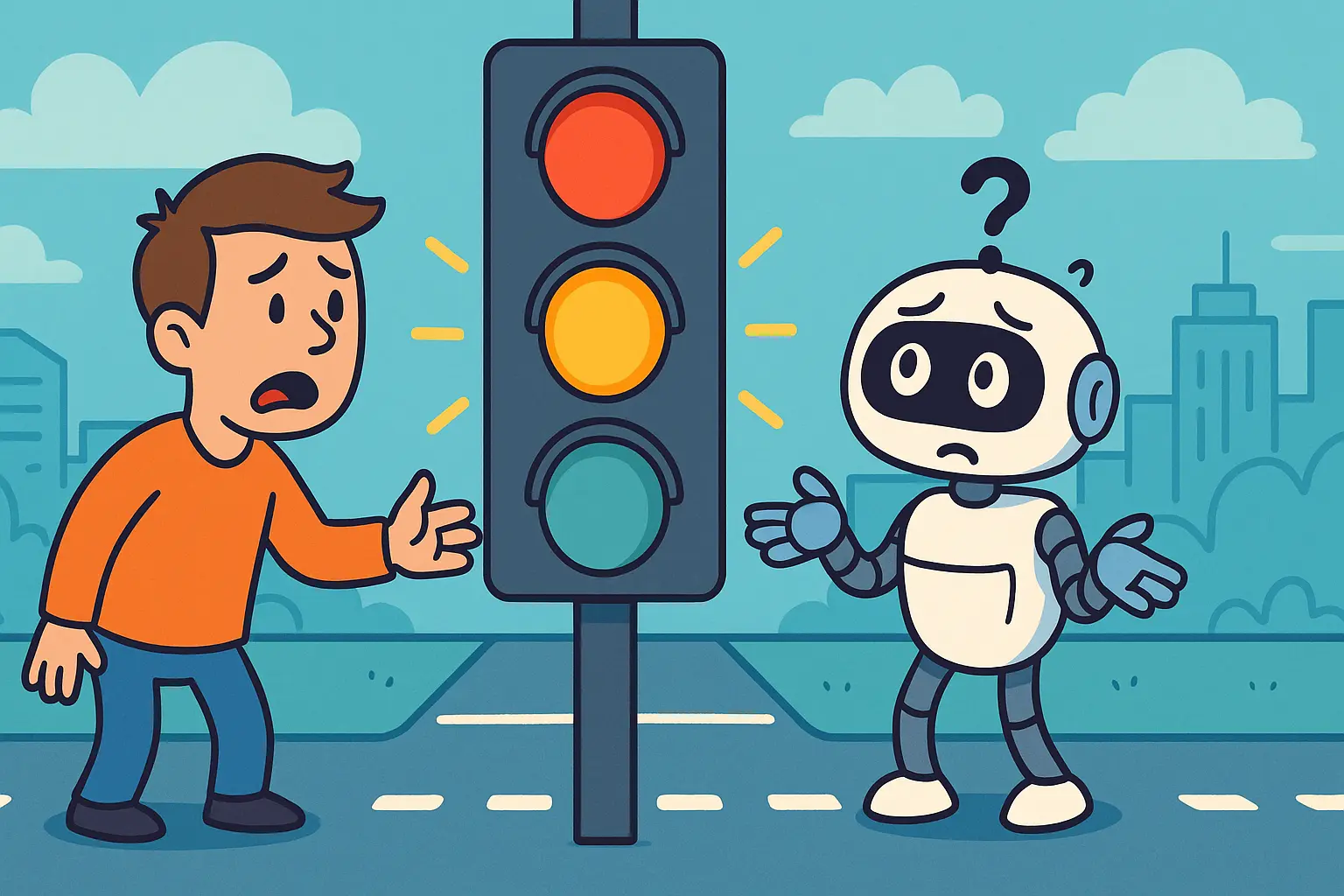There's a $97.2 billion dollar problem hiding in plain sight across enterprise AI deployments.
AI adoption has exploded. 78% of global companies now use AI in at least one business function, up from just 55% in 2023. Generative AI usage alone jumped from 33% to 71% in a single year. Some organizations are spending weekly on LLMs what they spent in all of 2023.
But only 25% of companies report widespread, fully enabled AI processes, and just 26% successfully turn AI pilots into real business value. The gap between AI investment and meaningful adoption is widening.
The reason comes down to optimizing for the wrong users.
The Three Colors of AI Adoption
When I think about AI adoption in organizations, I see three distinct groups:
🟢 AI Natives - They use AI tools daily, are comfortable with trial and error, and will thrash through bad experiences to find value. They're willing to learn prompt engineering, experiment with different models, and generally evangelize AI to anyone who will listen.
🟡 Curious Majority - They've heard AI can help them, they're intrigued by the demos, but they're also worried about the negative stories they've read. They want AI to work, but they're not willing to invest hours learning how to make it work.
🔴 Resistant Minority - They've decided AI is hype, dangerous, or not for them. They'll actively avoid AI tools and often need organizational mandate to engage at all.
AI companies spend 80% of their effort optimizing for 🟢. This makes sense from a product development perspective. 🟢s provide clear feedback, adopt new features quickly, and generate positive testimonials.
But 🟡 is where revenue lives and dies.
Why 🟡s Matter Most
In any organization rolling out AI tools, the distribution typically looks like this:
- 🟢 15-20%
- 🟡 60-70%
- 🔴 10-15%
🟡s represent the majority of your potential user base and, more importantly, they're the swing vote on whether your AI initiative succeeds or fails organizationally.
Recent research reveals that 70% of AI adoption obstacles are people and process related, not technical. The models work fine. The user experience doesn't.
🟢s will power through bad AI experiences. They'll blame their prompt, try a different approach, or switch models. 🟡s don't have that patience. One confusing response and they're suspicious. Two bad experiences and they're done. Not just with your tool, but often with AI altogether.
I've watched this play out repeatedly:
A marketing manager tries an AI writing assistant, gets generic output that doesn't match their brand voice, tries once more with a different prompt, gets something equally off-brand, and concludes "AI doesn't understand our business." They don't try again for months.
The marketing manager didn't fail at AI. The AI product failed at understanding their needs.
The Technical Metrics Trap
Most AI companies measure success through technical metrics: model accuracy, latency, token efficiency, safety benchmarks. These matter, but they're optimizing for the wrong outcome.
A model that scores 95% on technical evaluations can still create terrible user experiences. It's like saying QA will catch 100% of bugs. That's not true even in deterministic systems, much less stochastic ones.
Consider these scenarios where technical metrics miss user experience failures:
Scenario 1: The Perfectly Wrong Answer
- User: "Draft an email declining this vendor proposal"
- AI: Generates a grammatically perfect, professional email that's far too harsh for the company's relationship-focused culture
- Technical metric: ✅ Coherent, on-topic, well-structured
- User experience: ❌ "This AI doesn't understand how we communicate"
Scenario 2: The Confident Hallucination
- User: "What's our Q3 revenue growth compared to Q2?"
- AI: Provides specific percentages with confident language, but the numbers are completely fabricated
- Technical metric: ✅ Structured response, appropriate format
- User experience: ❌ "I can't trust anything this AI tells me"
Scenario 3: The Overwhelming Options
- User: "Help me write a product announcement"
- AI: Returns 800 words covering every possible angle, requiring significant editing
- Technical metric: ✅ Comprehensive, accurate, detailed
- User experience: ❌ "This takes longer than writing it myself"
Each of these scenarios would pass most technical evaluations while creating negative user experiences that push 🟡s toward 🔴.
What 🟡s Actually Need
🟡s don't need predictable AI, not perfect AI.
They want to know what to expect when they interact with an AI system. They want confidence that the AI understands their context, constraints, and communication style. Most importantly, they want to feel successful using AI, not frustrated by it.
Here's what moves 🟡s toward 🟢:
Immediate Value Recognition 🟡s need to see clear value in their first few interactions. Not potential value, not value after they learn better prompting. Immediate value that makes them think "this actually helped me."
Contextual Understanding AI that feels like it knows their industry, role, and company culture. A marketing AI that understands brand voice, a sales AI that knows the product positioning, a support AI that matches the company's tone.
Guardrails That Feel Helpful 🟡s appreciate when AI says "I'm not sure about this specific number, but here's what I do know" rather than confidently providing wrong information.
Progressive Disclosure Start simple, add complexity as users gain confidence. Don't overwhelm 🟡s with every feature and option upfront.
The Measurement Problem
Measuring 🟡 success is tricky. Traditional product metrics miss the nuance. Monthly active users doesn't tell you if users are having good experiences or just trying and failing repeatedly. Feature adoption doesn't distinguish between 🟢s diving deep and 🟡s struggling with basics.
We need new metrics that capture user sentiment and experience quality:
- Trust trajectory: Is user confidence in AI suggestions increasing or decreasing over time?
- Frustration patterns: Are users repeatedly trying similar requests without success?
- Value realization speed: How quickly do users achieve their intended outcome?
- Retention quality: Are users returning because they found value or because they're required to?
The encouraging news: 88% of organizations are now tracking value derived from AI adoption, indicating a shift from purely technical metrics to broader business and user impact measures. The challenge is that 🟡s often won't explicitly tell you when AI fails them. They'll just quietly stop using it. You need to read between the lines of their behavior.
Building for 🟡
If you're building AI products, here are concrete ways to optimize for 🟡r success:
1. Design for the Second Interaction Your demo gets someone to try your AI once. The second interaction determines if they become a user or join the ranks of AI skeptics. Make sure that second experience is better than the first.
2. Instrument User Sentiment Add simple feedback mechanisms to every AI interaction. Not just "thumbs up/down" but contextual feedback that helps you understand why something didn't work.
3. Create Success Templates Give users proven patterns that work. Instead of a blank prompt box, provide templates for common use cases in their role.
4. Show Your Work When AI makes suggestions, help users understand the reasoning. 🟡s are more likely to trust AI that explains its thinking than AI that just provides answers.
5. Fail Gracefully When AI encounters limitations, acknowledge them clearly. "I don't have enough context about your specific industry to provide detailed advice, but here's a general framework you can adapt."
The Business Case for 🟡s
Focusing on 🟡s isn't just good product strategy. It's good business strategy.
Current data shows that while AI adoption rates are hitting record highs, only 4% of companies are at the cutting edge of AI maturity. The gap between pilots and production value remains massive because most organizations haven't figured out how to serve their 🟡s effectively.
🟢s will adopt your AI regardless. They're already convinced. 🔴s won't adopt your AI regardless of what you build. They've already decided.
🟡s are the only group whose adoption you can actually influence through better product decisions. They're also the group that determines whether AI initiatives get organizational support or get quietly defunded.
When 🟡s have positive AI experiences, they become your best evangelists. They're not AI experts, so when they succeed with AI, their colleagues think "if Sarah can make this work, so can I."
When 🟡s have negative experiences, they become antibodies against AI adoption in your organization.
The Path Forward
The AI industry is at an inflection point. We've proven the technology works. Now we need to prove it works for normal people doing normal jobs.
This means shifting focus from impressive demos to consistent experiences. From perfect technical performance to predictable user value. From building for the AI-curious to building for the AI-cautious.
The companies that figure out how to serve 🟡s well won't just win market share. They'll expand the market itself. Every 🟡 who becomes 🟢 represents not just a customer, but a catalyst for broader AI adoption.
More powerful models will keep improving, but for teams building AI products, the bottleneck has shifted. It's no longer "can the model do this?" but "will users trust and adopt this?"
The future of AI products is about building trustworthy experiences on top of increasingly capable models.
And trust, unlike accuracy, can only be measured through the eyes of users.
What's your experience with AI adoption in your organization? Have you noticed the patterns I've described? I'd love to hear your thoughts - especially if you've found effective ways to support 🟡s in their AI journey.








